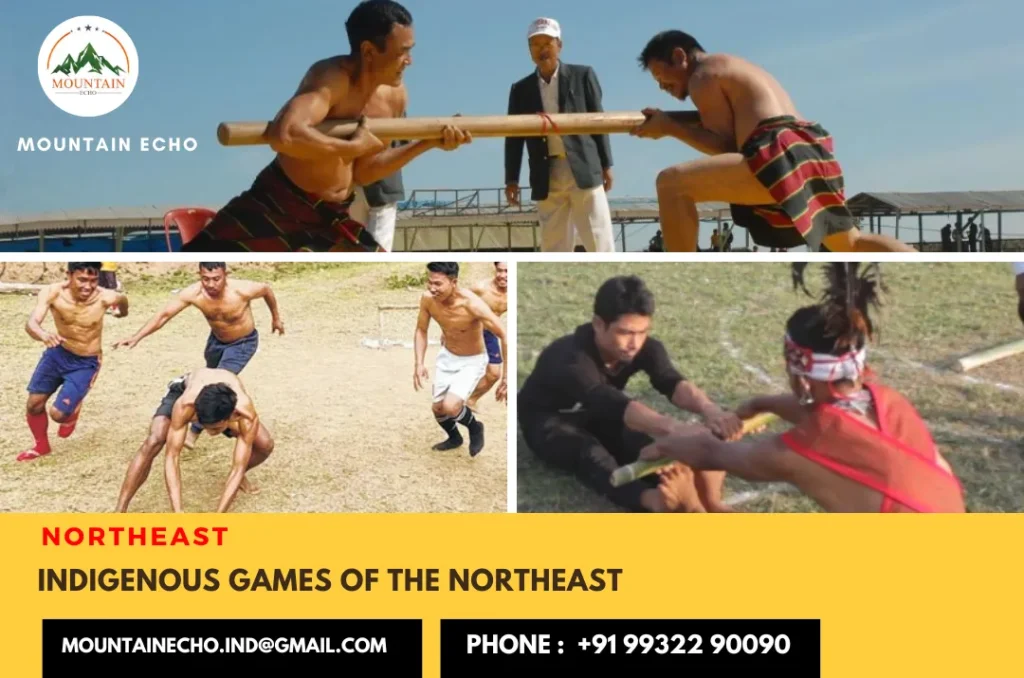Traditional indigenous games of the Northeast India
WhatsApp Channel
Join Now
Games and sports have always been integral part of the people of Northeast India. Many games and sports activities are played during social gatherings and festivals. While the present generation is more focused on playing modern games and sports, there still exists a significant number of traditional indigenous games that have been preserved and sustained through dedicated efforts. These age-old games not only carry historical and cultural value but also offer unique insights into the heritage of different communities.
Mahjong, Arunachal Pradesh
Mahjong is one of the traditional indigenous games of Arunachal Pradesh. It was developed in 19th century China. It is similar to the card game Rummy. It requires both strategy and luck to win the game.
It is played by three or four players with 136 or 144 small tiles which may have Chinese characters or symbols. It is a game which involves strategy, tactics and memory. The players pick up the tiles and discard them until any one of them has a winning combination called Mahjong. Each player starts with 13 tiles at the start of the game. The players need to form four sets of three and one pair of two identical tiles using a new tile (the 14th tile).
Dhopkhel, Assam
Dhopkhel, similar to the American game of Dodgeball, is an indigenous ball game from Assam. It is played during the Rongali Bihu festival. In earlier times, it used to be a royal game of the Ahom dynasty.
A rubber ball called ‘Dhop’ is used in the game. There are two teams with 11 players on each side. The game is played on a field of 125m x 80m having a central point in middle surrounded by a circle called gher.
The game begins with throwing the Dhop in the air. The player who catches the Dhop stand on the gher and throw it to the opposing team’s Katoni. If Katoni is hit they become Bondha. Bondha go to the opponent’s team, avoid their players, catch the ball, and return to their court without being touched.
Yubi Lakpi, Manipur
Yubi Lakpi, a game similar to Rugby, is an ancient game of Manipur played with a coconut. The ‘coconut snatching’ game (meaning in Manipuri language) is said to have connections with the mythological story of nectar stealing during the Samudra Manthan event.
The game is played with two sides having seven players on each side. One side becomes the God team which plays against the Evil team formed by the other side, similar to Devas and Asuras.
It is played on a field of 45m x 18m having no grass. Players play barefoot, bare-bodied, with only shorts. They oil themselves and the coconut to make things slippery. They carry the coconut under their arms, not against their chest. Kicking isn’t allowed. Players need to cross the end line and give the coconut to judges.
Roong Dea, Meghalaya
It is an ancient sport, similar to modern-day weightlifting, played by the Garo people of Meghalaya during the Wangala Festival.
This game involves participants demonstrating their strength by lifting a hefty, smooth round stone, weighing 100 kilograms or even more. The massive stone is placed among the onlookers. Each participant takes their turn to try and lift the massive stone, hoping to outdo the others. The game is open to all and anybody from amongst the spectators can try his luck in picking the stone. The participant who successfully lifts the stone to the greatest height is crowned the ultimate victor and declared the strongest.
Insuknawr, Mizoram
Insuknawr or rod – pushing, played only by men, is an indigenous game of Mizoram and has been declared as the Mizo National Game.
The game is played between two people inside a circle with a diameter of 16 to 18 feet. It is played with a rounded wooden rod or pole of diameter 3 to 4 inches having a length of 8ft. The objective of the game is to push the opponent outside the circle in 3 rounds.
Insuknawr begins with both players placing rods under their arms. Players can push each other out of the circle from the back or the side. If someone falls or the rod touches the ground, they lose points. These negative points help decide the winner if there’s a tie.
Pcheda, Nagaland
Pcheda is a traditional indigenous game of Nagaland that requires players to throw thin bamboo sticks from a set distance. It is a game of technique and muscle reflex played by the Southern Angamis to sharpen their skills.
Pcheda is played with dried grass stick called Opche. The players are divided into two groups. The groups compete to throw the grass stick to the farthest possible distance. Whoever throws the stick furthest is declared the winner.
Shoh, Sikkim
Shoh, is traditional game from Sikkim. The game originated in Tibet and is still common today. The word Shoh means dice in Tibet language.
It is very popular among worker class. This Shoh game is played using two dice with six sides each. These dice are shaken in a wooden bowl which is then upturned onto a pad made up of leather with a loud thump and a shout. The pad is kept in the middle of the board, inside a circle of shells and nine coins. Whichever player is able to move all nine coins across the board is declared the winner.
Achugwi Phan Sohlaimung, Tripura
It is a traditional wrestling game of Tripura played between two players to test their stamina. It is known as Thwngmung in the Tripuri language (Kokborok).
The players face each other on the ground in a sitting position with their legs stretched against each other. A thin tree or bamboo pole is placed between them for staking their legs. The players hold a long bamboo stick placed horizontally, suspended above the ground between them. They try to pull the stick to their own side. Whoever pulls the stick to his side wins the game.
Telegram Channel
Join Now



